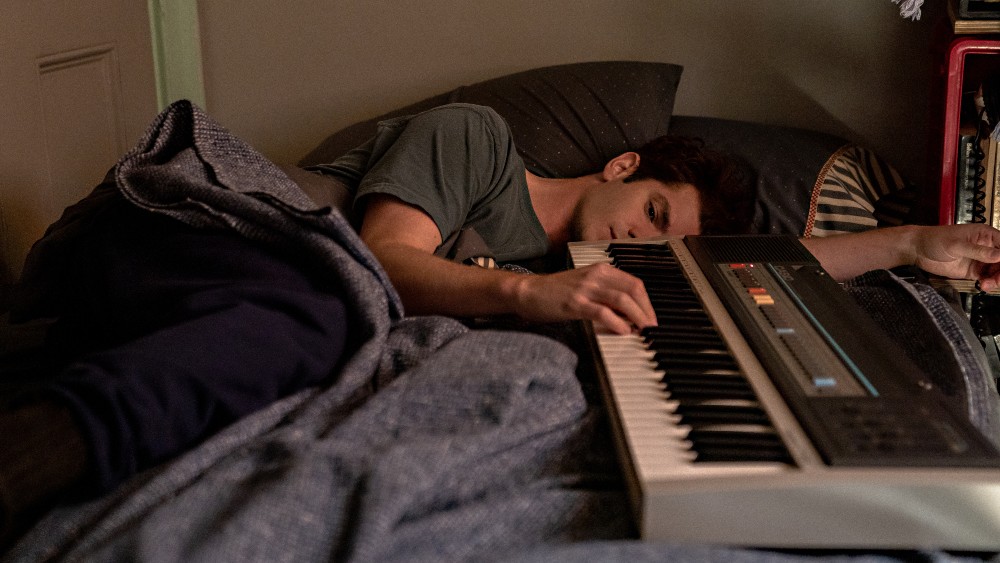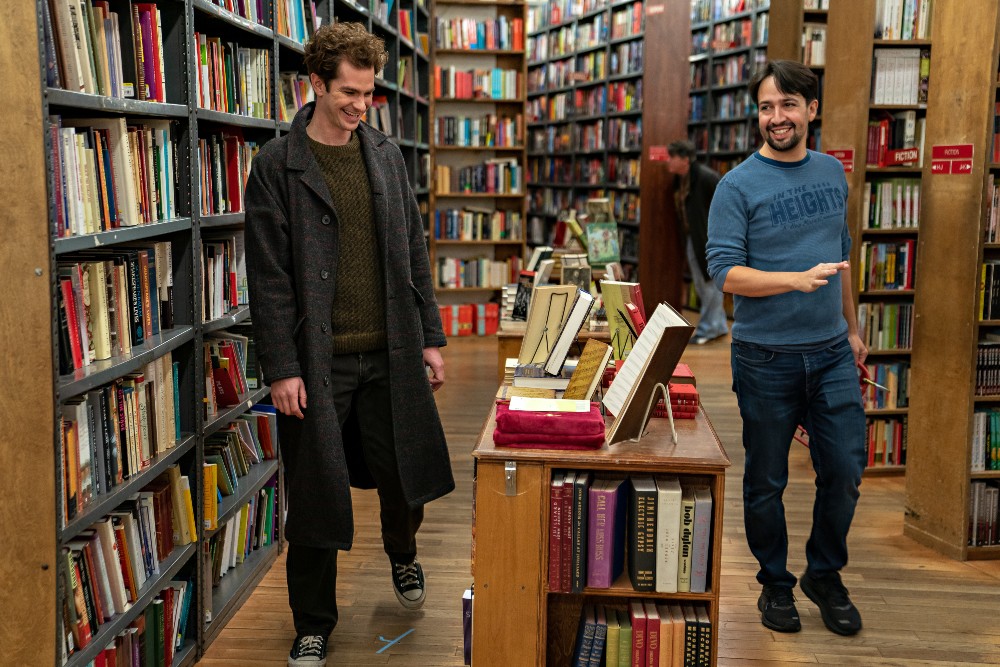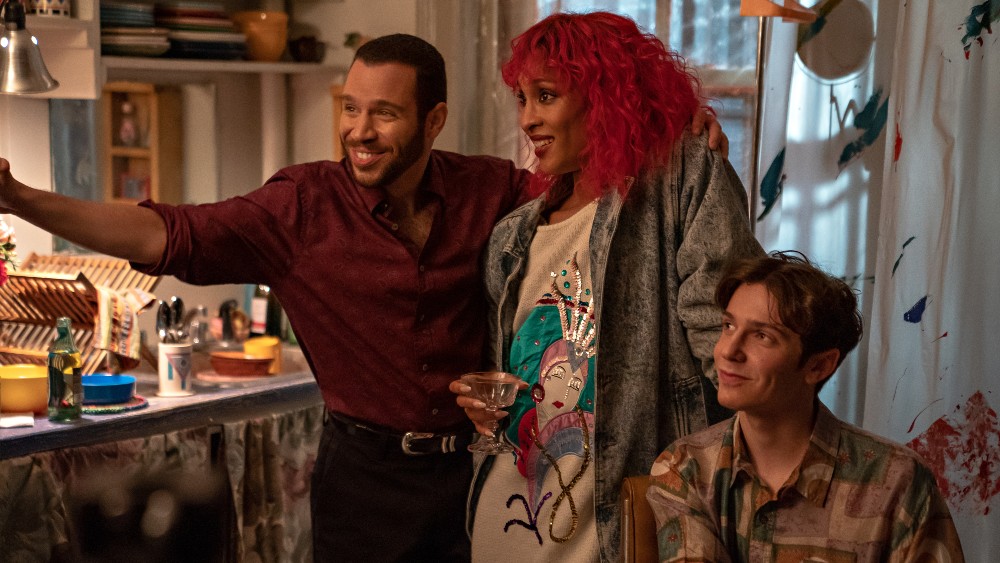
It seems somehow befitting that for his directorial debut, composing legend Lin-Manuel Miranda would select a musical adapted from a musical about making a musical. But while the plot of his film, Tick, Tick….Boom! can make your head spin—or explode, as the case may be—if you pay too much attention, fear not, because Lin Manuel and his talented cast ease you right into the proceedings with soft rock, catchy lyrics, and bemusing, straightforward choreography. The end result may be a film that is a tad too self-referential for all but the most devoted Broadway audiences, but that nevertheless tells a touching story with Andrew Garfield at its emotional core, in a career-best performance.
Tick, Tick….Boom! is adapted from the one-man musical of the same name, by Broadway composer Jonathan Larson. Larson is best known for the smash hit musical Rent, though the film adaptation of his lesser-known piece is miles better than the wobbly 2005 movie that failed to replicate the original’s success. But the original piece was a solo piece (though an autobiographical one), so Lin Manuel added bits and pieces to the tale to turn it into a film, with the help of experienced stage-to-screen screenwriter Steven Levenson (Dear Evan Hansen, the movie).

In the original show, a guy who is about to turn 30 waddles through a quarter-life crisis as his life-long ambition of being a successful Broadway producer does not take off, and he has to continue to live in the squalor of half-empty pizza boxes and soggy ramen noodle containers in some roach-infested, sixth floor NoHo walk-up. But this was 1990, so NoHo was simply known as the “dead area between SoHo and Greenwich Village,” the AIDS crisis was still ravaging New York City, and theater tickets cost a mere $50. Lin Manuel and Levenson add all of these details and more to create a richer world than the original’s, even if this world feels somewhat dated.
Garfield plays the lead, Larson himself, as he is working on one of his last failed pieces, Superbia. Surrounding him are his supportive girlfriend Susan (Alexandra Shipp), who he criminally neglects; his ambitious best-friend Michael (Robin De Jesus), struggling with many of the issues gay men confronted in New York in 1990; his unresponsive agent Rosa (Judith Light); and, occasionally, none other than Stephen Sondheim (Bradley Whitford) to lend a helping, inspiring hand.
As it probably was in real life, though, the star of the show is unquestionably Larson, as portrayed by Garfield in the most effective performance of his career. Larson is, in a word, manic. He is compulsive, self-involved, depressive, emotional, inspired, angry, and determined. Garfield hits all of these notes and navigates quickly and deftly between them, all while belting out almost all of the soft and hard rock tunes from the original musical. He gets a great assist by the talented Vanessa Hudgens, who plays Karessa Johnson, a young Broadway actress that performs Larson’s work at workshops and actual renditions. Garfield has the unenviable task of making sympathetic a character that is inherently selfish and treats most around him quite poorly. Sure, it helps that Larson is bohemian, a well-intentioned young liberal with much sympathy for AIDS patients, the down-trodden, and the anti-corporatists. Still, for those unawares of the entire trajectory of Larson’s life story, he is not an inherently likable character. Garfield’s principal achievement is that he gets you to really, really like him.

At various points, Tick, Tick….Boom! is a little too much through the looking glass, too self-referential, and too high on its own supply. Most audiences know only one piece of Larson’s work—Rent—so Miranda feels obligated to throw in constant references to that musical. These include the signature “speak” of the answering machine, naming a principal character “Roger,” the repeated portrayals of HIV+ gay men, and, perhaps most amusingly but also annoyingly, a scene with three homeless bums strolling the streets of New York played by three of the original stars who opened the show on Broadway (Adam Pascal, Daphne Rubin, and Wilson Heredia). The string of circular references does not end there. For one number, the song Sunday which Garfield/Larson sing with his coworkers at the Moondance Diner, Lin Manuel assembles as many Broadway luminaries as answered his phone call, including of course himself, Bebe Neuwirth, and others. After a while, you get the uneasy sense that not all are necessarily welcome into these festivities, full of self-reference, inside jokes, and wink-wink moments. For some audiences, frustration could come from trying to open up a layer of this film, only to find that, much like nested Russian dolls, there is nothing more than another musical reference waiting underneath.
When it comes to craft (beyond the Larson soundtrack), the highest accolades belong to Editor Andrew Weisblum (graduated from being Chicago’s Visual Effects Editor) and Cinematographer Alice Brooks. For the former, the hardest task is to exhibit self-control and not turn a show that is meant to focus on particular characters for extended periods into a schizophrenic mélange of cuts and pastiches. Weisblum’s editing is mostly muted and, therefore, effective. As for the latter, Brooks had to contend with the cramped spaces in Larson’s world, as well as with a constant back and forth between Larson on stage—performing Tick, Tick….Boom!—and Larson’s real life, which meant a perpetual toggle between natural and stage lighting for the camera. Brooks’ work was therefore critical in providing a steady foundation for Miranda’s endless parade of Broadway self-references.
In the end, it is hard to deny the compelling nature of stories of artists who are determined, who struggle, and who find success—even at some high costs to their own existences. It is hard to deny that the songs Larson wrote for this one-man show are effective in conveying his own insecurities, his own grittiness, his own emotions. And it is very hard to deny that Garfield took all of these elements to heart, made them his own and, perhaps for the first time in his career, imbued them with personal emotion, all cobbled together to deliver one of the best male performances of the year.
Grade: B+
Tick, Tick… Boom! is now playing in select theaters, and it will stream on Netflix starting November 19.
All photos courtesy and copyright Netflix. Photographer: Macall Polav.





